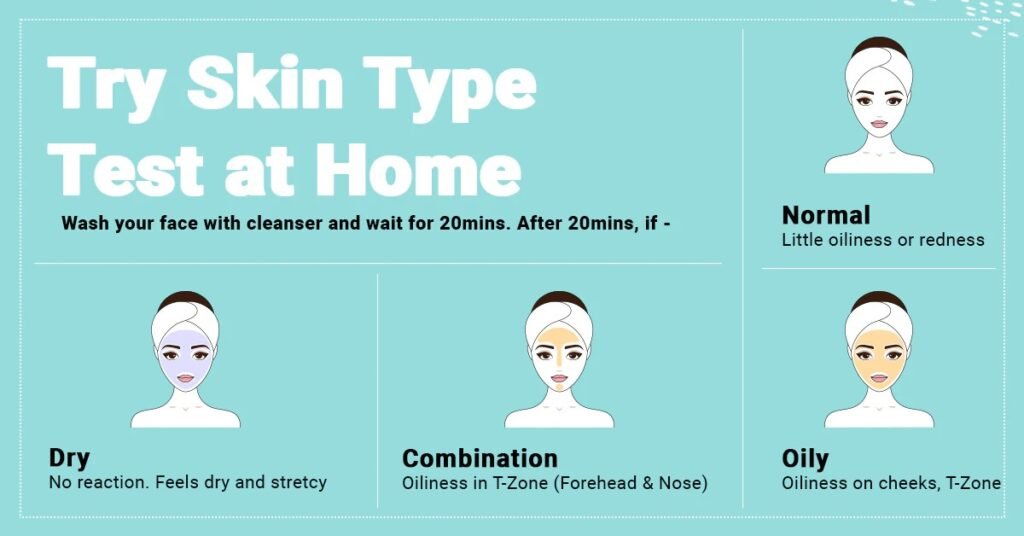Before we dive into the specifics, it’s essential to recognize that not all skin is created equal. Understanding your skin types is the crucial first step towards a tailored skincare routine that meets your unique needs. At Derma Advance, we’re committed to empowering you with the knowledge to make informed skincare decisions.
In this guide, we unravel the mysteries of different skin types, from oily to sensitive. You’ll discover:
- How to identify your skin type
- Characteristics and care tips for each skin type
- Expert advice to address your skin’s specific needs
This article is your gateway to a personalized skincare regimen that can transform your skin. Dive in to uncover how understanding your skin type can be the game-changer in your skincare routine.
How to Identify Your Skin Types?
Before diving into the specifics of each skin type, it’s essential to pinpoint your own. To help you determine your skin type accurately, we’ve created a simple at-home test. This quick and effective method involves washing your face and observing how your skin behaves without any products or moisturizers.

Follow these steps:
- Wash Your Face: Use a gentle, non-stripping cleanser to wash your face, removing all makeup and impurities.
- Leave It Alone: Allow your skin to rest and air-dry for 20 minutes without applying any products.
- Observe and Assess: After 20 minutes, examine how your skin feels and looks:
- Dry Skin: If your skin feels tight and looks flaky or rough, you likely have dry skin.
- Oily Skin: If your face appears shiny, particularly in the T-zone (forehead, nose, chin), and feels greasy, you probably have oily skin.
- Combination Skin: If you notice oiliness in the T-zone but dryness on the cheeks, you might have combination skin.
- Sensitive Skin: If your skin shows redness, irritation, or feels uncomfortable, it may be sensitive.
This test will give you a clearer idea of your skin type, allowing you to choose products and routines that are best suited for your needs. Check out the chart below for a visual representation of the test and further insights into each skin type.
Oily Skin: Characteristics and Care Tips

Characteristics:
- Shiny Appearance: Oily skin often has a noticeable shine, especially in the T-zone (forehead, nose, and chin). This can give the skin a greasy look shortly after cleansing.
- Enlarged Pores: Those with oily skin frequently experience larger, more visible pores. This can lead to clogged pores and make the skin more prone to blackheads and whiteheads.
- Frequent Breakouts: Due to excess oil production, oily skin is more susceptible to acne and frequent breakouts, particularly in high oil-production areas.
Care Tips:
- Use Oil-Free Products: Choose oil-free and non-comedogenic cleansers, moisturizers, and sunscreens to prevent clogged pores while providing necessary hydration and protection. For more details, check out our recommendations Oily Skin Care Products.
- Exfoliate Regularly: Use a gentle exfoliator with salicylic acid to remove dead skin cells and prevent clogged pores. Salicylic acid can penetrate oily skin, cleansing pores effectively.
- Regularly Cleanse and Tone: Cleanse your face twice a day to remove dirt, oil, and impurities. Follow up with a toner containing witch hazel or niacinamide to control oil production and reduce pore appearance.
- Targeted Treatments: Consider incorporating treatments like benzoyl peroxide or retinoids to reduce breakouts and improve overall skin texture. Find out more in our Acne Treatment Services.
Dry Skin: Characteristics and Care Tips

Characteristics:
- Flaky or Rough Texture: Dry skin often feels tight and rough, with visible flaky patches that can be uncomfortable and unsightly.
- Redness or Irritation: Dry skin is prone to redness and irritation, especially in colder climates or after exposure to harsh weather. These dry patches can be sensitive to touch.
- Dull Appearance: Without enough moisture, dry skin tends to have a dull, lackluster appearance, lacking the natural radiance seen in well-hydrated skin.
Care Tips:
- Use Hydrating Products: Incorporate rich, moisturizing cleansers and serums that are designed to replenish your skin’s moisture barrier. Look for products with ingredients like hyaluronic acid, glycerin, and ceramides that attract and lock in moisture. check out some best moisturizers available in India Top Moisturizers for Dry Skin.
- Avoid Hot Water: Washing your face with hot water can strip away natural oils, leading to further dryness. opt for lukewarm water to cleanse your skin gently without causing additional irritation.
- Apply Moisturizer: Choose thicker creams or oils that are formulated to lock in moisture, especially during colder months when your skin needs extra protection. Products with shea butter, jojoba oil, and squalane are particularly effective.
- Seek Expert Help for Chronic Dry Skin: If you’re experiencing a long-term condition characterized by dry, itchy, and inflamed skin, such as eczema, it’s essential to consult a specialist. These conditions often appear on areas like the face, neck, hands, and legs. Visit our site for expert help and tailored care plans.
Combination Skin: Characteristics and Care Tips

Characteristics:
- Varied Texture: Combination skin is characterized by having an oily T-zone (forehead, nose, and chin) and dry or normal skin in other areas of the face. This mixed texture can make finding the right skincare routine challenging.
- Uneven Skin: With different needs for different areas, combination skin often requires a tailored approach to address both oily and dry patches effectively.
Care Tips:
- Balance Your Routine: To maintain balance, use different products for the T-zone and the drier areas. For example, a mattifying toner can be used in the T-zone to control oil, while a hydrating serum can be applied to the cheeks and other dry areas. This targeted approach ensures that each part of your face gets the care it needs.
- Choose Multi-Functional Products: opt for products that cater to multiple skin needs. For instance, a lightweight, non-comedogenic moisturizer can hydrate without clogging pores, making it suitable for both oily and dry areas. Visit Best Products for Combination Skin to explore our recommendations.
- Regular Exfoliation: Exfoliate regularly to help maintain balance and prevent clogged pores, particularly in the T-zone. Gentle exfoliants containing salicylic acid or alpha hydroxy acids (AHAs) can help clear away dead skin cells and control oil without over-drying the skin.
- Protect with SPF: Sunscreen is essential for all skin types, but for combination skin, choose a non-greasy, broad-spectrum SPF that won’t clog pores in the oily areas. We recommend products that offer UVA/UVB protection and have a matte finish.
- Adjust with the Seasons: Combination skin can change with the seasons, becoming oilier in the summer and drier in the winter. Adapt your skincare routine accordingly by switching to more hydrating products in the colder months.
Sensitive Skin: Characteristics and Care Tips

Characteristics:
- Redness or Irritation: Sensitive skin is easily triggered by products, environmental factors, and even stress, leading to persistent redness and irritation. This skin type often reacts quickly to changes in temperature, humidity, or skincare products, making it crucial to adopt a gentle routine.
- Itching or Burning Sensation: After applying certain products, you might feel a tingling, itching, or burning sensation. This discomfort can be a sign that your skin’s barrier is compromised or that the product contains ingredients that are too harsh for your sensitive skin.
- Prone to Allergies: Sensitive skin is often allergic to various ingredients, especially common irritants like fragrances, alcohol, and certain preservatives. Allergic reactions can manifest as hives, swelling, or rashes, making it essential to scrutinize product labels before use.
Care Tips:
- Test Products First: Always patch-test new products before applying them to your entire face. Apply a small amount of the product to a discreet area (like behind your ear) and wait 24 hours to see if any reaction occurs. This precaution can save you from potential irritation or allergic reactions.
- Moisturize Regularly: Sensitive skin tends to have a compromised barrier, which makes it more prone to dryness and irritation. Moisturizing regularly helps to strengthen the skin barrier and provides a protective layer against environmental aggressors.
- Avoid Over-Cleansing: Washing your face too frequently can strip away the natural oils and worsen sensitivity. Stick to cleansing twice a day with a mild, non-foaming cleanser to maintain your skin’s natural balance.
- Consult a Dermatologist: If your sensitive skin frequently reacts to products or you’re dealing with persistent issues like acne or other severe skin conditions, it’s time to seek professional help. Visit our experts at Derma Advance for personalized treatment plans and effective solutions tailored to your unique skin needs.
